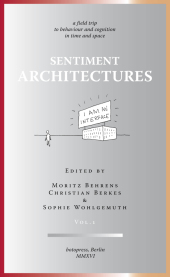 Neuerscheinungen 2016Stand: 2020-02-01 |
Schnellsuche
ISBN/Stichwort/Autor
|
Herderstraße 10
10625 Berlin
Tel.: 030 315 714 16
Fax 030 315 714 14
info@buchspektrum.de |

Moritz Behrens, Christian Berkes, Sophie Wohlgemuth
(Beteiligte)
Sentiment Architectures
A Field Trip to Behaviour and Cognition in Time and Space
Herausgegeben von Behrens, Moritz; Berkes, Christian; Wohlgemuth, Sophie
1st ed. 2016. 72 p. w. many full coloured & black-and-white plates. 243 mm
Verlag/Jahr: BOTOPRESS 2016
ISBN: 3-946056-05-9 (3946056059)
Neue ISBN: 978-3-946056-05-8 (9783946056058)
Preis und Lieferzeit: Bitte klicken
A panopticon that allows for its inmates to be visually observed at all times is a Sentiment Architecture. A fortified panic room that provides shelter for people to take refuge in case of a threat is a Sentiment Architecture. A participatory media installation is a Sentiment Architecture. Sentiment Architecture is not a typology. It is a function. That is why we use its plural, Sentiment Architectures. This book is many books: It features a brief media history, a fantastic fiction (by Sebastian Michael), a contemporary architectural theory, a documentation on the Sentiment Cocoon, interviews (with two of ARUP´s engineers), and two essays - one on light, information and physical form (by Konstantinos Mavromichalis) and one on corporate influence in tech and art projects (by Elvia Wilk).
A panopticon that allows for its inmates to be visually observed at all times is a Sentiment Architecture. A fortified panic room that provides shelter for people to take refuge in case of a threat is a Sentiment Architecture. A participatory media installation is a Sentiment Architecture. Sentiment Architecture is not a typology. It is a function. That is why we use its plural, Sentiment Architectures.
The term is derived from a technology called sentiment analysis - a tool to identify people´s emotions in language. The contents of this book try to utilise this idea and its potential for an expanded architectural theory and practice. Following this approach, Sentiment Architectures are not either positive or negative. They are part of our world. They are part of us. And that is why we have to attain a conscious understanding and handling of them. This is what this collage-like publication is aiming for. It meanders through a variety of forms to encounter this phenomenon in all its modes of existence: A socio-critical utopia, a subjective history, a real-world documentation, a satellite essay, an individual mythology, and two interviews create a picture of our world where subject and object collided and fused into one a long time ago. We think it is about time for architects to acknowledge that more actively.
Content
p. 7
Editorial Notes
p. 9
Sebastian Michael: Earth Portal Report 513118-000816. A Sentiment Utopia
p. 13
Moritz Behrens, Christian Berkes & Sophie Wohlgemuth: Towards Sentiment Architectures. A Partial History
p. 29
Moritz Behrens: The Sentiment Cocoon - from Research to Practice (and Back). A Reflexive Documentation
p. 49
Elvia Wilk: Spaces for Art and Tech in and Beyond Corporate Influence. transmediale 2015: Capture All
p. 57
Konstantinos Mavromichalis: Blending Light, Information and Physical Form. An Individual Mythology
p. 61
Nigel Tonks: A Brief Interview On Responsiveness and Idealised Bodies
p. 63
Tristram Carfrae: A Brief Interview On Data Driven Design and Architecture
p. 65
Epilogue, A Quote (1970)
At the 2016 Media Architecture Biennale in Sydney the Sentiment Cocoon (Moritz Behrens and team) has won the Media Architecture Award in the category Participatory Architecture and Urban Interaction."I do deeply share the efforts to bring forward the expanded architectural issue around responsiveness & mediation of multiple dimensions. The book begins with Sebastian Michael´s sheer imaginative, lightweight, but deeply meditational text, continues with an attractive atlas of sentiment architectures - in which I share quite a lot of indexes - then comes to the intriguing cocoon project itself, and at the end diffuses towards the black-paged interviews. Yes, it is a nice field trip into the realm of Great Intelligent Virtual Energies." Mihye An (ETH Zurich), author of Atlas of Fantastic Infrastructures: An Intimate Look at Media Architecture


